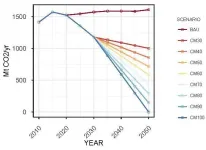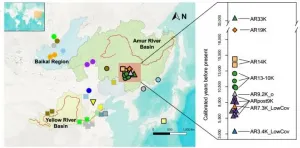(Press-News.org) CAMBRIDGE, MA -- Nitrogen, an element that is essential for all living cells, makes up about 78 percent of Earth's atmosphere. However, most organisms cannot make use of this nitrogen until it is converted into ammonia. Until humans invented industrial processes for ammonia synthesis, almost all ammonia on the planet was generated by microbes using nitrogenases, the only enzymes that can break the nitrogen-nitrogen bond found in gaseous dinitrogen, or N2.
These enzymes contain clusters of metal and sulfur atoms that help perform this critical reaction, but the mechanism of how they do so is not well-understood. For the first time, MIT chemists have now determined the structure of a complex that forms when N2 binds to these clusters, and they discovered that the clusters are able to weaken the nitrogen-nitrogen bond to a surprising extent.
"This study enables us to gain insights into the mechanism that allows you to activate this really inert molecule, which has a very strong bond that is difficult to break," says Daniel Suess, the Class of '48 Career Development Assistant Professor of Chemistry at MIT and the senior author of the study.
Alex McSkimming, a former MIT postdoc who is now an assistant professor at Tulane University, is the lead author of the paper, which appears today in Nature Chemistry.
Nitrogen fixation
Nitrogen is a critical component of proteins, DNA, and other biological molecules. To extract nitrogen from the atmosphere, early microbes evolved nitrogenases, which convert nitrogen gas to ammonia (NH3) through a process called nitrogen fixation. Cells can then use this ammonia to build more complex nitrogen-containing compounds.
"The ability to access fixed nitrogen on large scales has been instrumental in enabling the proliferation of life," Suess says. "Dinitrogen has a really strong bond and is really unreactive, so chemists basically consider it an inert molecule. It's a puzzle that life had to figure out: how to convert this inert molecule into useful chemical species."
All nitrogenases contain a cluster of iron and sulfur atoms, and some of them also include molybdenum. Dinitrogen is believed to bind to these clusters to initiate the conversion to ammonia. However, the nature of this interaction is unclear, and until now, scientists had not been able to characterize N2 binding to an iron-sulfur cluster.
To shed light on how nitrogenases bind N2, chemists have designed simpler versions of iron-sulfur clusters that they can use to model the naturally occurring clusters. The most active nitrogenase uses an iron-sulfur cluster with seven iron atoms, nine sulfur atoms, a molybdenum atom, and a carbon atom. For this study, the MIT team created one that has three iron atoms, four sulfur atoms, a molybdenum atom, and no carbon.
One challenge in trying to mimic the natural binding of dinitrogen to the iron-sulfur cluster is that when the clusters are in a solution, they can react with themselves instead of binding substrates such as dinitrogen. To overcome that, Suess and his students created a protective environment around the cluster by attaching chemical groups called ligands.
The researchers attached one ligand to each of the metal atoms except for one iron atom, which is where N2 binds to the cluster. These ligands prevent unwanted reactions and allow dinitrogen to enter the cluster and bind to one of the iron atoms. Once this binding occurred, the researchers were able to determine the structure of the complex using X-ray crystallography and other techniques.
They also found that the triple bond between the two nitrogen atoms of N2 is weakened to a surprising extent. This weakening occurs when the iron atoms transfer much of their electron density to the nitrogen-nitrogen bond, which makes the bond much less stable.
Cluster cooperation
Another surprising finding was that all of the metal atoms in the cluster contribute to this electron transfer, not only the iron atom to which the dinitrogen is bound.
"That suggests that these clusters can electronically cooperate to activate this inert bond," Suess says. "The nitrogen-nitrogen bond can be weakened by iron atoms that wouldn't otherwise weaken it. Because they're in a cluster, they can do it cooperatively."
The researchers' findings also confirmed that simpler versions of the iron-sulfur cluster, such as those they created for this study, can effectively weaken the nitrogen-nitrogen bond. The earliest microbes to develop the ability to fix nitrogen may have evolved similar types of simple clusters, Suess says.
Suess and his students are now working on ways to study how the more complex, naturally occurring versions of iron-sulfur clusters interact with dinitrogen.
INFORMATION:
The research was funded by the MIT Research Support Committee Fund.
A massive genome-wide association study (GWAS) of genetic and health records of 1.2 million people from four separate data banks has identified 178 gene variants linked to major depression, a disorder that will affect one of every five people during their lifetimes.
The results of the study, led by the U.S. Department of Veterans Affairs (V.A.) researchers at Yale University School of Medicine and University of California-San Diego (UCSD), may one day help identify people most at risk of depression and related psychiatric disorders and help doctors prescribe drugs best suited to treat the disorder.
The study was published May 27 in the journal Nature Neuroscience.
For the ...
The research - by the University of York - gives scientists a new tool that will support the development of new varieties.
The research led to scientists being able to develop an adaptable framework for describing gene content and order across all Brassica species.
Lead author, Professor Ian Bancroft, Chair of Plant Genomics at the Centre for Novel Agricultural Products (CNAP), at the Department of Biology said: "The research has helped us understand the trajectory of how genomes evolve in brassicas. We can use this new knowledge, for example, to accelerate the exchange of beneficial genes between Brassica species."
Brassica vegetables, such as broccoli, cabbage, kale, pak choi and swede, along with brassica oil crops such as ...
Swiftness is essential when treating lung cancer, the second most common type of cancer in the U.S. and the country's leading cause of cancer deaths. For patients with early-stage non-small cell lung cancer, surgical removal of a tumor-infested lung or of a smaller lung section may be the only treatment needed.
However, some patients postpone surgery while seeking second opinions, because of economic or social factors, or for personal reasons such as waiting until after a child's wedding or a planned vacation. Worries about contracting COVID-19 in a clinical setting also have led to delays.
But a new study by researchers at Washington University School of Medicine ...
With the COP Climate conference in Glasgow only a few months away, the ambitions of the Paris Agreement and the importance of taking action at the national level to reach global climate goals is returning to the spotlight. IIASA researchers and colleagues have proposed a novel systematic and independent scenario framework that could help policymakers assess and compare climate policies and long-term strategies across countries to support coordinated global climate action.
The Paris Agreement defines a long-term temperature goal for international climate policy: "holding the increase in the global average temperature to well below 2°C above pre-industrial levels and pursuing efforts to limit the temperature increase to 1.5°C". Its achievement critically ...
A study led by research groups of Prof. FU Qiaomei from the Institute of Vertebrate Paleontology and Paleoanthropology (IVPP) of the Chinese Academy of Sciences and Prof. ZHANG Hucai from Yunnan University covers the largest temporal transect of population dynamics in East Asia so far and offers a clearer picture of the deep population history of northern East Asia.
The study was published in Cell on May 27.
Northern East Asia falls within a similar latitude range as central and southern Europe, where human population movements and size were influenced by Ice Age climatic fluctuations. Did these climatic fluctuations have an impact on the population history of northern East Asia?
Stories uncovered by ancient DNA in East Asia remain relatively underexplored. The population ...
BOSTON - Although everyone can benefit from exercise, the mechanistic links between physical fitness and overall health are not fully understood, nor are the reasons why the same exercise can have different effects in different people. Now a study published in Nature Metabolism led by investigators at Beth Israel Deaconess Medical Center (BIDMC) provides insights related to these unanswered questions. The results could be helpful for determining the specific types of exercise most likely to benefit a particular individual and for identifying new therapeutic targets for diseases related to metabolism.
"While groups as a whole benefit from exercise, the variability in responses between any two individuals undergoing the very ...
Geneva, 27 May 2021 - A total investment in nature of USD 8.1 trillion is required between now and 2050 - while annual investment should reach USD 536 billion annually by 2050 - in order to successfully tackle the interlinked climate, biodiversity, and land degradation crises, according to the State of Finance for Nature report released today.
The report finds that annual investments in nature-based solutions will have to triple by 2030 and increase four-fold by 2050 from the current investments into nature-based solutions of USD 133 billion (using 2020 as base year).
The authors of the report - produced by ...
UNIVERSITY PARK, Pa. -- A Penn State scientist studying crystal structures has developed a new mathematical formula that may solve a decades-old problem in understanding spacetime, the fabric of the universe proposed in Einstein's theories of relativity.
"Relativity tells us space and time can mix to form a single entity called spacetime, which is four-dimensional: three space-axes and one time-axis," said Venkatraman Gopalan, professor of materials science and engineering and physics at Penn State. "However, something about the time-axis sticks out like sore thumb."
For ...
The way the human brain works remains, to a great extent, a topic of controversy. One reason is our limited ability to study neuronal processes at the level of single cells and capillaries across the entire living brain without employing highly invasive surgical methods. This limitation is now on the brink of change.
Researchers led by Daniel Razansky, Professor of Biomedical Imaging at ETH Zurich and the University of Zurich, have developed a fluorescence microscopy technique that facilitates high-resolution images of microcirculation without the ...
Bethesda, MD (May 27, 2021) -- Crohn's disease, a type of inflammatory bowel disease (IBD) that causes inflammation (pain and swelling) in the gastrointestinal tract, can cause daily health problems, frequent hospitalizations and surgery when not adequately controlled. While there is no cure for Crohn's disease, there are treatments that can help patients live a symptom-free life.
After a detailed review of available literature, the American Gastroenterological Association (AGA) has released new clinical guidelines outlining the benefits and risks of each drug currently available to Crohn's patients. Based on this research, AGA recommends the early introduction of biologics for patients experiencing luminal and fistulizing Crohn's disease rather than waiting ...



